
This means most can work worldwide with nothing more than an adapter to account for the physical plug differences - no voltage transformer needed.Ĭheck your power supplies before you travel, of course, but it’s very, very convenient. If you look closely at the small print on many power supplies, you’ll see they’re rated for anything from 100 to 250 volts. When it comes to modern power supplies, however, almost anything works. 1 You’re also likely to damage the device. Plug a device expecting 110 volts into a 220-volt socket, and you’ll probably see sparks followed by darkness as the circuit breaker trips. Input voltage - aka “mains” or line-voltage - is, of course, critical. Check out Why Does My Phone Charge More Quickly on Some Chargers? Input voltage Turns out USB devices can be smart enough to use more powerful chargers more effectively. USB power supplies, for example, are the same no matter what. The good news here is that there are some standards where the polarity is always correct. Look carefully for indicators on both the power supply and the device. There’s no getting around this.įailure to get it right at best just doesn’t work, but at worst can damage the device. If the device expects the center connector to be positive and the outer ring to be negative, your power supply’s connector must match. Particularly when it comes to popular circular power connectors, make sure the expectations match. (Image: Three-quarter-ten, CC BY-SA 3.0, via Wikimedia Commons) Here’s the catch: just because the physical plug fits into your device does not mean that the polarity is correct. Which wire is which is referred to as polarity. Most power supplies provide their output on two wires: one labeled (+) or positive, and the other (-) or negative. The polarity of the connection between your charger and device must be correct. In other words, there is nothing wrong with having a charger capable of providing more amps than needed. Thus, as long as you replace your power supply with one capable of providing as much or more amps than the previous, you’ll be fine.

The device being charged may be damaged.The device may charge extremely slowly.The problem, of course, is the reverse: if your device needs 1.0 amps, but your charger is rated at only 0.5 amps, then any of several problems could result: If your device needs 0.5 amps to charge, and your charger is rated at 1.0 amps, only 0.5 amps will be used. A device being charged will only take as much amperage as it requires.

The amperage rating of a charger or power supply is the maximum it can supply. Amperage Provided Versus Amperage Required Power Supply or Charger Amperage Rating Result Greater than the device’s requirement The amperage provided by your charger must match or exceed what the device being charged requires. Sidestep all those unknowns and make sure to get exactly the right voltage from the start. Some may tolerate a wide range of input voltages, while others are extremely sensitive to even the smallest error. If the voltage is off by enough, it can damage your device.Īnd here’s the problem: there’s no way to say what’s enough or too much. Depending on how different the supplied voltage is from what’s required, the device may simply fail, it may work “kind of”, or it may appear to work at the cost of a much shorter lifespan. Others, unfortunately, are not tolerant at all. Some devices are tolerant of variations and work just fine. It’s very important to get the right voltage. In your case, the old charger supplied 19 volts, so your replacement must also be 19 volts. When replacing a charger, this is easy to determine: it’ll be listed somewhere on the old charger. Specifically replacing the power supply for a laptop? Check out: Can I Use a Higher Wattage Power Supply With My Laptop?


 0 kommentar(er)
0 kommentar(er)
